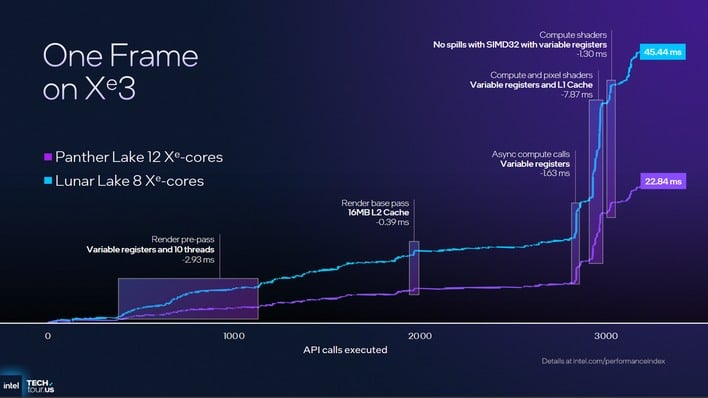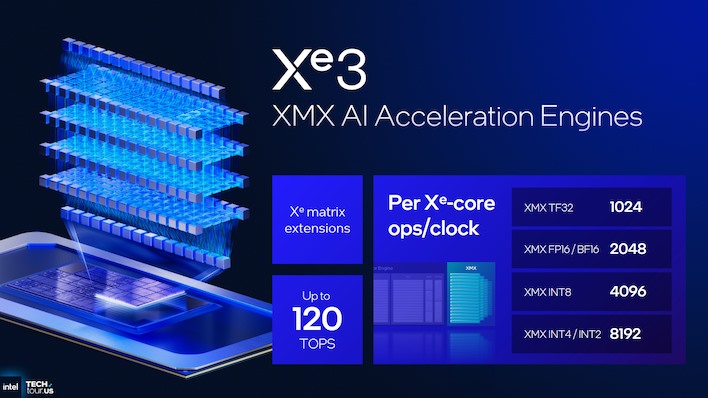Intel Claims Panther Lake's Xe3 iGPU Will Set A New Standard In Graphics
A Bigger, Meaner Integrated GPU
We just posted up a technical preview of Intel's Xe3 graphics architecture as implemented in Panther Lake, but if you're in a hurry, Xe3 represents Intel's third generation Xe architecture, following Lunar Lake's Xe2 and Meteor Lake's Xe-LPG designs. This iteration doubles down on both scale and efficiency. Intel confirmed that Panther Lake's iGPU can feature up to 12 Xe3 cores, up from 8 Xe2 cores in Lunar Lake—a 50% increase in core count—but the company isn't relying on raw scale alone: it claims more than 50% faster graphics performance versus Lunar Lake, and over 40% better performance per watt compared to Arrow Lake.The Xe3 architecture refines the same fundamental building blocks that powered Xe2, but nearly every subsystem has been reworked. Each render slice now packs six Xe3 cores (up from four in Xe2), and each core still contains eight 512-bit vector engines and eight 2048-bit XMX matrix engines—but with a 33% increase in L1 cache and shared local memory (SLM). These improvements add up to a significant jump in throughput without bloating power draw or die area.
Intel is also claiming major architectural optimizations at the micro-level. According to internal metrics, Xe3 doubles anisotropic filtering and stencil test rates, doubles ray–triangle intersection performance, delivers 2.4× faster mesh rendering, and can achieve up to 7.4× faster depth writes. Vector engines can now handle 25% more threads thanks to a new variable register allocation system, which dynamically balances workload pressure. There's also a reworked raster backend featuring a unified return buffer (URB) to streamline data flow between functional units.
All of this adds up to a more coherent, balanced architecture that wastes less silicon and clock cycles doing housekeeping. Intel says that the emphasis for the new architecture was on "consistent performance," which is very welcome, as previous-generation Arc GPUs, both integrated and otherwise, have struggled with frame-time consistency.
Intel's AI-Ready Silicon
AI acceleration is also getting a serious push. Intel's GPUs already handle roughly half of the AI workloads in recent AI PC designs, and Xe3 continues that trend with expanded XMX matrix compute power—up to 120 TOPS on the GPU alone. That kind of throughput puts it within striking distance of some discrete entry-level GPUs, at least in mixed-precision workloads like FP16 or INT8 inference.The increased AI muscle ties into Intel's broader "agentic PC" vision, where on-device silicon handles language models and assistant-style workflows without cloud dependence. In that sense, Panther Lake isn't just about gaming; it's about making integrated GPUs a core component of local AI acceleration along with the integrated NPU, which you can read more about in our technical preview.
Enter XeSS-MFG: Multi-Frame Generation
At Intel's Tech Tour, we learned that one of Xe3's flagship features will be XeSS-MFG, or multi-frame generation. Building on Intel's extant AI-based upscaling tech, XeSS-MFG uses neural inference to predict not just one, but up to three in-between frames per rendered frame, similar to how NVIDIA's version of the tech works. In practice, that means the iGPU can double, triple, or even quadruple apparent frame rates, depending on the configuration. The tech will debut exclusively on Xe3 with Panther Lake but will later roll out to Xe2/Battlemage and possibly even older Xe/Alchemist products.Frame generation is a tricky technology to get right—latency and visual artifacts can quickly ruin the illusion—but Intel's previous work on XeSS 2.0 suggests that the blue teams' graphics guys have built a solid foundation. If XeSS-MFG works as well as NVIDIA's, it could make integrated graphics viable for smooth 1080p and even 1440p gaming without needing a discrete GPU.



